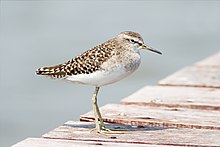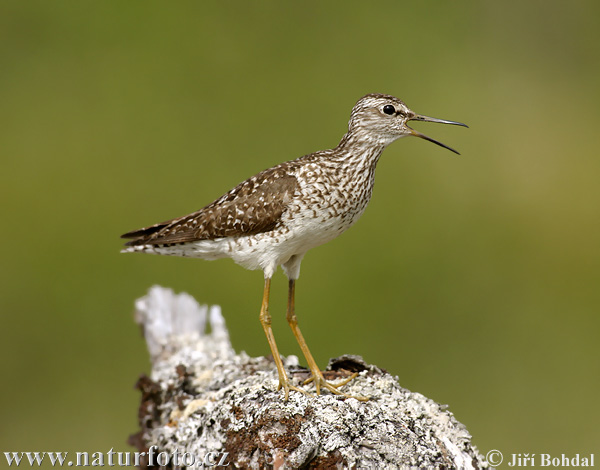Wood Sandpiper
Wood Sandpiper (Tringa glareola )
The Wood Sandpiper (Tringa glareola ) is a Eurasian bird of the family of the Waders ( Scolopacidae ). He is a breeding bird of the temperate and boreal to subarctic Tundrenzone. In Central Europe it is a very rare, occurring only locally breeding and summer bird. He is a frequent and regular observed during the migration period as migratory birds and resting birds.
- 6.1 Literature
- 6.2 External links
- 6.3 Single Documents
Appearance
The 19-21 inches long and 50-90 gram Sandpiper has a wingspan from 36 to 40 centimeters. The Sandpiper is so scarce star big. He is very similar to the Green Sandpiper, but his legs are slightly longer. Also, the bright eyes slipping over is more striking than the Green Sandpiper.
The body top is gray-brown, but lighter than the Green Sandpiper. The contrast with white underparts is therefore less noticeable. The wing underside is light gray, the white tail has five to eight fine, in the middle of something blurry cross bands. In breeding plumage sandpiper have dense white spots on the body top. Head and neck are finely striated.
In flight it calls giff giff giff. The alarm call is a repeated gip - gip - gip.
Confusion possibilities especially with the Green Sandpiper. The distribution area overlaps especially in the southern, ie nichtarktischen part with the breeding area of the fracture water strider. The Green Sandpiper is also quite dark.
Occurrence
The breeding grounds of the Wood Sandpiper stretches from Scotland and Norway to Eastern Siberia, Kamchatka and the Pribylow Islands. The Sandpiper is predominantly a long-distance migrant. Its winter quarters are found in tropical to subtropical regions of the southern hemisphere. In the Western Palearctic the northern boundary of the winter quarters along the south coast of the Mediterranean Sea and the south of Asia Minor runs. Drag as a wide front puller over Central Europe and Western Europe, south-southwest direction. Important resting places on this train can be found on the northern edge of the Mediterranean, for example, in the Po Valley and in the Camargue, where up to 50,000 individuals can be observed. Migratory birds are also observed in the Ebro Delta. Wetlands International identified as an important resting, wintering areas and breeding areas, six European territories. Of these, four are in Finland, where only the wetlands in the province of Oulu as a resting place during migration has a meaning. The other is areas with a high density of breeding birds. Two other important resting places in Greece and Sweden ( mouth of the Ume älv ).
The Sandpiper breeds preferably in raised bogs with low trees and on open water and in swamps of the taiga and tundra. Further to the east of its range it can also be observed in denser stands of trees near water. On the passage and in the winter quarters of the Wood Sandpiper is much more adaptable, but he prefers fresh waters. To observe it is including in the food-rich shallow water, on mud flats and flooded meadows and Altwasserarmen of rivers.
Behavior
Sandpipers are diurnal, but they often move at night. Thanks to its relatively long toes it can also run on floating algal mats and floating leaves of aquatic plants. During the breeding season the wood sandpiper is territorial. A Singflug used for territorial marking and consists of fluting calls. The Sandpiper can be 9-11 years old.
Reproduction
Sandpiper build their nest usually well hidden in vegetation on the ground. In Fennoscandia and Russia Sandpipers use similar green sandpiper and tree nests of thrushes and other songbirds. Ground nests are depressions that are lined with material from the environment. The onset of lay in Central Europe before the end of April, but usually in early May. In Fennoscandia breeding sandpipers begin laying eggs usually not before mid-May. The main laying period is the beginning of June here. The clutch consists of four eggs. These are top-shaped and have a light brownish to greenish color and dark - reddish brown spots. The incubation period is 22 to 23 days, both parents birds breed. The young birds are able to fly at 28 to 30 days.
Stock
Current inventory and inventory development
The total European population is estimated at 350000-1200000 breeding pairs. Of this breed 75000-750000 breeding pairs in the European part of Russia and 270000-440000 breeding pairs in Fennoscandia. In Central Europe the species is only represented in Poland as a breeding bird. There breed between three to five breeding pairs. By Moor destruction this type has disappeared in central Europe up to the few breeding pairs in Poland and also in Scandinavia the stock has fallen. She is listed in Annex I of the EU Birds Directive ( 79/409/EEC RL ), are so expel to protect bird sanctuaries.
Sandpipers were still up in the 19th century regular breeding birds in the lowlands in north- central Europe. The Central European breeding grounds ranged from the Netherlands to Poland. Due to habitat loss from the second half of the 19th century there was a significant decline in population numbers and area tasks. Thus, the sandpiper had disappeared as a breeding bird in the 19th century from Mecklenburg- Vorpommern. From the 1960s, the last remaining populations need together in Central Europe. Thus, the breeding population in Schleswig -Holstein went from 47 breeding pairs in 1968 to five breeding pairs in 1979 back. Cause of stock decline in Central Europe is a destruction of raised bogs by drainage, industrial peat extraction and afforestation of peatlands. Similar to the golden plover is assumed that climatic causes of the large-scale area loss are responsible.
Inventory forecasts
The Sandpiper is considered how many other Waders as one of the species that will be particularly affected by climate change. A research team, commissioned by the British Environment Agency and the Royal Society for the Protection of Birds, the future diffusion trend of European breeding birds examined on the basis of climate models, assumes that significantly shrink the distribution area of the fracture water strider until the end of the 21st century and after will move north. South of 63 degrees latitude of the Sandpiper will hatch after these forecasts only in Norway and in the Urals. The few current Central European breeding areas will expire accordingly. New potential distribution areas of Novaya Zemlya to arise and on Svalbard, but the area south losses can not offset.






)



